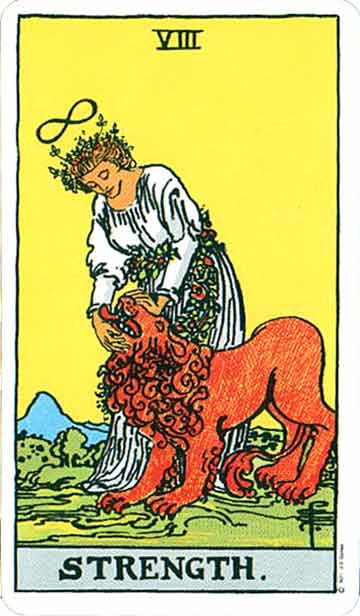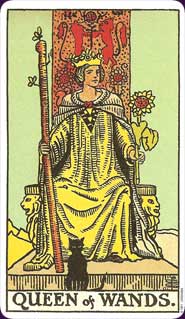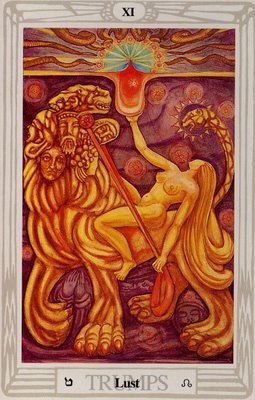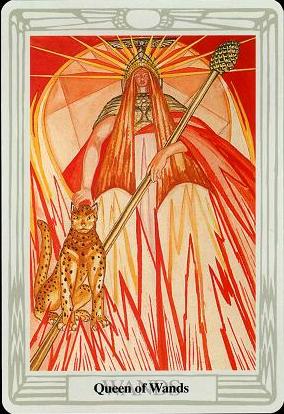Tarot Symbolism: A Tale of Two Kitties
For a large number of people around the world, our feline companions bring us joy, endless amazement, friendship and fun. In fact, much like the ancient Egyptians, the Western world has built something of a cult around the domestic cat, with people proudly displaying their love on plaques, signs and bumpers stickers that read “Love me, love my catsâ€, or “Dogs have owners, cats have staffâ€. In fact, us “cat people†like to stick together, particularly against those “dog peopleâ€, and you’ll find that if you’re not a cat lover conversation is harder with us. There is also an old Irish saying, “Beware of people who don’t like cats.â€
Luckily, our feline companions have found their way into the Tarot pack, and specifically they keep court in two cards in the Rider Waite Smith pack: Strength and the Queen of Wands. In the Strength card we meet nature’s big cat, the lion, a powerful and wild beast, capable of killing a man should it wish to. Whereas at the feet of the Queen of Wands sits a demure, pretty, domestic black cat. Both cards also feature women in power roles, flowers, and fiery colours. The cats give us the biggest clue though: these two cards are linked in the Tarot via the symbol of Leo.

Astrologically speaking, Strength in the Tarot is associated with the sign of Leo, the Lion. It is easy to see this in the image of the virginal maiden taming the red lion, though it is unclear to the reader whether she is opening the lion’s mouth or closing it, or perhaps trying to take a peek inside. In fact, if we look closely at the image, we see that the lion’s tongue is sticking out as if trying to lick the maiden, and if she were to forcefully push its jaws closed we would soon find ourselves with a tongueless lion.
Our Queen of Wands also finds herself associated with the sign of Leo, as the apportioning of Knights, Queens and Kings of the Tarot gives her this fixed Fire sign of the zodiac. The presence of the cat at her feet reminds us of the association with Leo, but the question remains: why no big cat? Why choose a black, domestic cat for the Queen of Wands and the lion for Strength?
The answer, I think, lies partly in alchemical symbolism, and partly in the folkloric associations of black cats, with a smidgeon of knowledge of cat behaviour.
The Red Lion in Alchemy represents sulphur, the “masculine†component in the coagulum of parts that go towards creating the Philosopher’s Stone. It presents to us symbolically everything that is active, assertive, and fiery both in the world around us and in ourselves. More correctly in alchemical procedure the Red Lion refers to the red tincture that comes after the white tincture (represented by the White Queen/Eagle/Unicorn), which represents an integration of polarities. We see this red lion elsewhere in the Aleister Crowley’s Thoth Tarot, in which it is shown clearly on the Lovers card as the animal companion of the Red King, also the Emperor from the earlier trump, during his marriage to the White Queen, also the Empress, whose animal companion is the White Eagle. It is interesting that our RWS Strength card features a woman in white: perhaps she can be seen as the White Queen herself, the Empress in another form, and Strength therefore is another part of the process of solve e coagula which occurs sometime between the Lovers and Temperance/Art in the Thoth Tarot. It is interesting that the White Queen in Strength is in human form and the Red King in his animal form, indicating that he is still in a more primal part of his essence, undiluted by the white tincture. Alchemically speaking, since the white tincture comes before the red in the process, it would make sense that the White Queen is human and the Red King still animal: in the Strength card he has yet to be integrated and refined. It would be more apt, then to say that the Strength card is integrative of the bestial, primal side of nature, rather than taming it; instead of ruling over it, we must mingle with it in symbiosis. This is why the Lust card from the Thoth Tarot (see below) is perhaps a better illustration of this process, since in that image the relationship between Beauty and Beast is not one of power over, but one of power with and within, a symbiotic one. Beauty marries the Beast in the tales, and in some she even becomes a beast herself in order to be his bride.

The black cat in the Queen of Wands does not have such lofty associations, but certainly more recognizable ones. Black cats are witches cats after all, and with them comes an air of mystery, magic, and power. The Queen of Wands is perhaps the most “dangerous†of all the queens, yet still well-loved. As the Queen of the suit of Fire, she channels and nurtures the energies of passion, ambition, achievement, personality, the ego, drive, sexuality, sensuality, and magic. Wands are the symbol of the magician or sorcerer’s will directed towards their goal, and thus the Queen of Wands, being a channel (Queens are associated with Water, and therefore the powers to carry and reflect, flow and nurture) herself, can be seen as the magic wand itself. She doesn’t need tools to work her magic: she uses her very being. This is the femme fatale, the sexy witch that can use glamour and attraction spells to make you 100% hers. She’s like pheromones, the ultimate social control and universal language of sexual attraction. Crowley describes this Queen as the fluidity and colour of fire, in other words the part of fire that makes us stare into it for hours on end, or that attracts the small child fascinated with it, leading to burned fingers. These are the dancing, elegant, hypnotic flames. In just the same way, the cat is a graceful, elegant creature, but they can be vicious if threatened and manipulative when territory is at stake.

The female cat in her sexual prime (called a “queen†too!) gives us another clue as to the nature of the Queen of Wands. The oestrus cycles (also called “heat†or “being in callâ€) of a female cat repeat as often as every two or three weeks in the warmer months of the year. The activity of a female cat during oestrus is overt: she will call to go outside, rub herself against people and objects and present her rear to people and other animals. She will be single-minded in her efforts to mate. Cats are highly sexual and territorial creatures, and very loudly so: you are as likely to hear the loud screeches of cats mating as of cats fighting. Female cats also frequently mate with several males in a single night, and her ovulation is triggered by the barbs on the male’s penis. The act of mating is possibly quite painful for the female, firstly due to these barbs and secondly because the male must first fight her to subdue her – she is not easily won! In just the same way, the Queen of Wands may make a show of her sensual and sexual nature to anybody who cares to see it, being outspoken and confident in her beauty, her personality and her concept of self, but when it comes to anything more than flirtation she becomes a warmaiden, challenging anybody who would try and obtain power over her in any way. And, just like a cat, give the Queen of Wands lots of attention and she’ll reward you with as much return affection as she deems necessary, but fail to do so and you may find that she becomes cold to you, perhaps even looking elsewhere for the attention she craves (who knows, maybe she is getting fed by about three different households every day anyway?)

In a reading the two feline cards of Strength and the Queen of Wands can symbolically represent different modes of power, and particularly stances that can be taken in the face of one’s threatened power or a power struggle. Strength, with its alchemical and zodiacal lion/beast, wild and primal, can represent power on a more abstract level: inner power, power that is stored up to be released when absolutely necessary; also the power of integration and symbiosis as opposed to the drawing of barriers for protection. There is wisdom in the idea that those who place themselves in vulnerable positions are often the ones with the most strength; those who rely upon barrier to protect are – like the Four of Coins – sometimes weaker, with fewer natural defences. The Queen of Wands, with her domestic black cat, represents a power that is carefully reserved, controlled, and used to manipulate and create an outcome or future desirable to her. Manipulation, unfortunately, has so many negative connotations, but they are not necessarily intended here. One can manipulate clay to create sculptures, for instance. The Queen of Wands has power on a social, everyday level, whether it is a role in a community, or just power she has given herself through her correct wielding of her understanding and confidence. Â
Two different kitties, but both still linked to the essential qualities of the zodiacal kitty, Leo: confidence, personality, strength of will and character, assertiveness, action, power and rulership. And despite the Queen of Wands featuring a “domesticated†version of this feline zodiac sign, she is just as powerful as her Leonine counterpart in Strength: a force to be reckoned with, truly a sight to behold.
Kim Huggens is the author of “Tarot 101: Mastering the Art of Reading the Cards” (Llewellyn, 2010), co-creator of “Sol Invictus: the God Tarot” (Schiffer, 2007) and the forthcoming “Pistis Sophia: the Goddess Tarot” with artist and fellow Tarot enthusiast Nic Phillips. She’s also a cat lover, being the proud compaion of a beautiful, strange, amazing 5-year old black domestic moggy named Erzulie.
http://pistissophiatarot.com
www.kimhuggens.com

Thanks for the card
Wonderful article Kim! Simply wonderful. As a cat-lover too I can wholeheartedly relate! I love your style of writing and the clarity that you magically bring with your insights. Thank you!
Brilliant blog – I really enjoyed reading this – thanks.
Well done, Kim!